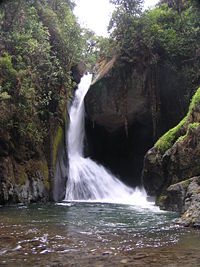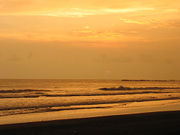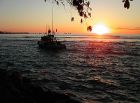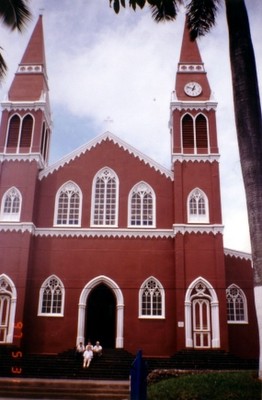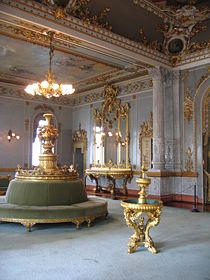Difference between revisions of "Costa Rica" - New World Encyclopedia
m (→Politics) |
|||
| Line 104: | Line 104: | ||
==Flora and Fauna== | ==Flora and Fauna== | ||
[[image:Anhinga b.jpg|left|thumb|right|[[Anhinga]] drying its feathers]] | [[image:Anhinga b.jpg|left|thumb|right|[[Anhinga]] drying its feathers]] | ||
| − | Costa Rica is home to a rich variety of [[plant]]s and [[animal]]s. While the country has only about 0.1% of the world's land mass, it contains 5% of the world's [[biodiversity]]. | + | |
| + | Costa Rica is a true tropical paradise. It is home to a rich variety of [[plant]]s and [[animal]]s. While the country has only about 0.1% of the world's land mass, it contains 5% of the world's [[biodiversity]]. Unique and exotic fruits and vegetable grow here and are consumed in a vast array of Tico cuisine. Over 25% of Costa Rica is composed of protected [[forest]]s and reserves. | ||
One national park that is internationally renowned among [[ecology|ecologists]] for its biodiversity (including big cats and [[tapirs]]) and where visitors can expect to see an abundance of wildlife is the [[Corcovado National Park]]. | One national park that is internationally renowned among [[ecology|ecologists]] for its biodiversity (including big cats and [[tapirs]]) and where visitors can expect to see an abundance of wildlife is the [[Corcovado National Park]]. | ||
Revision as of 04:47, 25 October 2006
| |||||
| National motto: ¡Pura vida! (So Alive!) | |||||
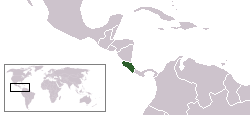
| |||||
| Official language | Spanish | ||||
| Capital | San José | ||||
| President | Abel Pacheco | ||||
| Area - Total - % water |
Ranked 125th 51,100 km² 0.7% | ||||
| Population - Total (2004 est.) - Density |
Ranked 122nd 4,159,757 81.40/km² | ||||
| Independence | 1821 | ||||
| Currency | Colón | ||||
| Time zone | Universal Time -6 | ||||
| National anthem | Noble patria, tu hermosa bandera (Noble fatherland, your beautiful flag) | ||||
| Internet TLD | .cr | ||||
| Country Calling Code | 506 | ||||
The Republic of Costa Rica is a country in Central America, bordered by Nicaragua to the north, Panama to the south-southeast, the Pacific Ocean to the west and south, and the Caribbean Sea to the east. Costa Rica is seen as an example of political stability in the region, and is sometimes referred to as the "Switzerland of the Americas". Costa Rica was the first country in the world to constitutionally abolish the army.
Geography
Costa Rica is located on the Central American isthmus, 10° North of the equator and 84° West of the Prime Meridian. It borders both the Caribbean Sea (to the east) and the North Pacific Ocean (to the west), with a total of 1,290 km of coastline (212km on the Caribbean coast and 1016 km on the Pacific).
Costa Rica also borders Nicaragua to the north (309 km of border) and Panama to the south-southeast (639 km of border). In total, Costa Rica comprises 51,100 km², of which 50,610 km² is land and 440 km² is water, making it slightly smaller than the U.S. state of West Virginia and about half the size of Ireland.
The highest point in the country is Cerro Chirripo, with 3,810 m (approximately 12,515 feet), the second highest peak in Central America, after Volcan Tajumulco in Guatemala. The highest volcano in the country is the Irazú Volcano (3,431 m or 11,257 feet).
Costa Rica also comprises several islands. Cocos Island stands out because of its distance from continental landmass (24 km², 500 km from Puntarenas coast), but Calero Island is the biggest island of the country (151.6 km²).
The largest lake in Costa Rica is Lake Arenal. The country is highly recognized and praised for its national park system: a developed and progressive system which stresses on ecotourism. Costa Rica protects over 25% of its national territory within national parks.
History of Costa Rica
In Pre-Columbian times the Native Americans in what is now Costa Rica were part of the Intermediate Area located between the Mesoamerican and Andean cultural regions. This has recently been redefined to include the Isthmo-Colombian area, defined by the presence of groups that spoke Chibchan languages. These groups are also believed to have created the Stone spheres of Costa Rica, between 200 B.C.E. and AD 1600.
The native people of the Mayans and Aztecs were conquered by Spain in the 16th century. Costa Rica was then the southernmost province in the Spanish territory of New Spain. The provincial capital was in Cartago.
After briefly joining the Mexican Empire of Agustín de Iturbide (see: History of Mexico and Mexican Empire), Costa Rica became a state in the United Provinces of Central America (see: History of Central America) from 1823 to 1839. In 1824, the capital moved to San José. From the 1840s on, Costa Rica was an independent nation.
Costa Rica has avoided the violence that has plagued Central America. Since the late 19th century only two brief periods of violence have marred its democratic development. In 1949, José Figueres Ferrer abolished the army; and since then Costa Rica has been one of the few countries to operate within the democratic system without the assistance of a military.
Costa Rica (Spanish for "Rich Coast"), although still a largely agricultural country, has achieved a relatively high standard of living. Land ownership is widespread and Electronics is a rapidly expanding industry.
Politics
Costa Rica is a democratic republic with a strong system of constitutional checks and balances. Executive responsibilities are vested in a president, who is the country's center of power. There also are two vice presidents and a 15-member cabinet that includes one of the vice presidents. The president and 57 Legislative Assembly deputies are elected for 4-year terms. A constitutional amendment approved in 1969 limited presidents and deputies to one term, although a deputy may run again for an Assembly seat after sitting out a term. An amendment to the constitution to allow second presidential terms was proposed and also the constitutionality of the prohibition against a second presidential term has been challenged in the courts. In 2003 the prohibition was officially recognized, in a highly polemic resolution, as anti-constitutional allowing Óscar Arias (Nobel Peace Prize, 1987) to run for President a second time in the 2006 elections. Arias is promoter of free trade and supports the free trade agreement with the United States. Costa Rica uses a form of proportional representation to elect its national legislative body.
Governors appointed by the president head the country's seven provinces, but they exercise little power. There are no provincial legislatures. Autonomous state agencies enjoy considerable operational independence; they include the telecommunications and electrical power monopoly, the nationalized commercial banks, the state insurance monopoly, and the social security agency. Costa Rica has no military by constitution and maintains only domestic police and security forces for internal security.
Economy
Costa Rica's economy is dependent on ecotourism, agriculture, and, more recently, exports of electronic circuits. Costa Rica's location in the Central American isthmus provides easy access to American markets as it has the same time zone as the central part of the United States and direct ocean access to Europe and Asia.
The economy has been booming for Costa Rica because the Government had implemented a seven year plan of expansion in the high tech industry. They have tax exemptions for those who are willing to invest in the country. With their high level of educated residents, they make an attractive investing location. Several global high tech corporations have already started developing in the area exporting goods.
The unit of currency is the colón (CRC), which trades around 450-500 to the U.S. dollar; currently about 600 to the euro.
Flora and Fauna
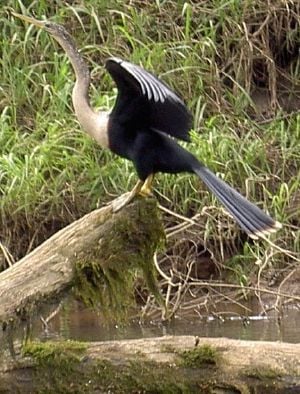
Costa Rica is a true tropical paradise. It is home to a rich variety of plants and animals. While the country has only about 0.1% of the world's land mass, it contains 5% of the world's biodiversity. Unique and exotic fruits and vegetable grow here and are consumed in a vast array of Tico cuisine. Over 25% of Costa Rica is composed of protected forests and reserves.
One national park that is internationally renowned among ecologists for its biodiversity (including big cats and tapirs) and where visitors can expect to see an abundance of wildlife is the Corcovado National Park.
Tortuguero National Park is home to spider, howler and White-throated Capuchin monkeys, the Three-toed sloth, 320 species of birds (including eight species of parrots), and a variety of reptiles.
The Monteverde Cloud Forest Reserve hosts 2,000 plant species including numerous orchids. Over 800 types of bird can be found here, as well as over 100 species of mammal.
Demographics
In the central part of the country, most people are of European descent but some are also Mestizos (to varying degrees). Because of little intermarriage, most of the population today retain European complexions. The pure indigenous population today numbers about 29,000, less than one percent of the population. In Guanacaste, most of the population descends from a mix of the Chorotega Indians, Bantu Africans and Spaniards. Descendants of black 19th-century Jamaican immigrant workers constitute an English-speaking minority and at three percent of the population number about 96,000. Costa Ricans of mestizo and European descent account for a combined 94 percent (the vast majority being of Spanish decent). Another one percent is ethnically Chinese. [[1]] In addtion there are many Americans who either come to retire or move to the country to live.
Today there is a growing number of Amerindians who migrate for seasonal work opportunities as agricultural workers mainly in the south-eastern border region with Panama. The most important group of immigrants in Costa Rica are Nicaraguans, who represent ten percent of the population. Most of them were originally refugees from civil war during the late 1970s and 1980s, but after the Esquipulas Peace Agreement an increasing number of Nicaraguans continue to migrate into Costa Rica due to economic reasons. There is also a growing number of Colombian, Panamanian and Peruvian immigrants.
Culture
In Costa Rica, the locals refer to themselves as tico, maje or mae (sort of "man", actually maje means "dumb") idiom in a very popular and "only with close friends" way, or tica (female). "Tico" comes from the locally popular usage of "tico" diminutive suffixes (eg. 'momentico' instead of 'momentito'). The tico ideal is that of a very friendly, helpful, laid back, unhurried, educated and environmentally aware people, with little worry for deadlines or the "normal" stresses of United States life. Visitors from the United States are often referred to as gringos, which is virtually always congenial in nature. The phrase "Pura Vida" (literally pure life) is a motto ubiquitous in Costa Rica. It encapsulates the pervading ideology of living in peace in a calm, unflustered manner, appreciating a life surrounded by nature and family and friends.
Costa Rican traditions and culture tend to be almost indentical to Spanish Culture or European culture. Their accent with every-day used words is the most Spanish sounding among Central America, if not in Latin America in general. Costa Rica boasts a varied history. Costa Rica was the point where the Mesoamerican and South American native cultures met. The north west of the country, Nicoya, was the southernmost point of Nahuatl cultural influence when the Spanish conquerors (conquistadores) came in the 16th century. The center and south portions of the country had Chibcha influences. However the Indian people influenced Costa Rica as a whole very little as much of the Indians died from disease and mistreatment of the Spaniards. The Atlantic coast was populated with African slaves due to the practice of enslavement in the 17th and 18th centuries. In addition, during this 19th century thousands of Chinese and Italian families came to the country to work on the construction of the railroad system connecting the urban populations of the Central Plateau to the port of Limon on the Caribbean.
External links
- Wikitravel guide to Costa Rica
- ICT official tourism site (English | Spanish | Deutsch | Français)
- Banco Central de Costa Rica Central Bank Costa Rica
- Constitution of the Republic of Costa Rica (In Spanish)
- Costa Rica City Guide - Message Board and Photo Gallery (free site).
- Instituto Costarricense de Turismo Official Costa Rican Tourism Portal
- Links by the government web site
Template:Central America
Credits
New World Encyclopedia writers and editors rewrote and completed the Wikipedia article in accordance with New World Encyclopedia standards. This article abides by terms of the Creative Commons CC-by-sa 3.0 License (CC-by-sa), which may be used and disseminated with proper attribution. Credit is due under the terms of this license that can reference both the New World Encyclopedia contributors and the selfless volunteer contributors of the Wikimedia Foundation. To cite this article click here for a list of acceptable citing formats.The history of earlier contributions by wikipedians is accessible to researchers here:
The history of this article since it was imported to New World Encyclopedia:
Note: Some restrictions may apply to use of individual images which are separately licensed.


